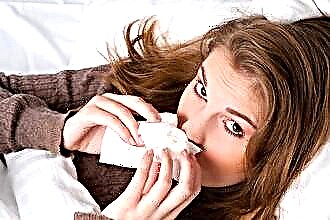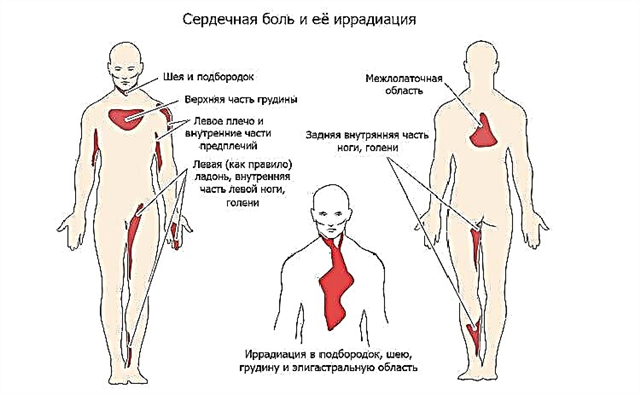An increase in temperature with angina is due to the toxic effect of a pathogenic pathogen. Streptococcus or staphylococcus, penetrating into the oropharynx, has a local effect on the cells of the tonsils, leading to the development of inflammation in them. In response to this effect, defense mechanisms are triggered to neutralize the destructive effect of bacteria. One of these protective mechanisms is an increase in body temperature.
The development of hyperthermia in response to the introduction of an infectious agent is a positive process, indicating the body's struggle with a pathogenic pathogen and sufficient immunity. At the same time, measures aimed at combating hyperthermia are unjustified and cannot contribute to a speedy recovery. Their use can only be due to such a development of the situation when an increase in temperature significantly worsens the patient's condition.
The need to lower the temperature
 Most often, such actions aimed at lowering body temperature become necessary when it comes to a newborn baby, whose condition worsens over time. Such a child becomes lethargic, vomiting, convulsions, or loss of consciousness may be noted. An increase in temperature is also dangerous if it is accompanied by a sharp pallor of the child's skin, when the skin becomes marbled, and the hands and feet become cold when touched. The presence of these signs indicates the involvement of the vascular component in the development of a temperature reaction and is an absolute indication for the use of antipyretics in a child.
Most often, such actions aimed at lowering body temperature become necessary when it comes to a newborn baby, whose condition worsens over time. Such a child becomes lethargic, vomiting, convulsions, or loss of consciousness may be noted. An increase in temperature is also dangerous if it is accompanied by a sharp pallor of the child's skin, when the skin becomes marbled, and the hands and feet become cold when touched. The presence of these signs indicates the involvement of the vascular component in the development of a temperature reaction and is an absolute indication for the use of antipyretics in a child.
Non-drug products
However, before seeking help for drugs, experts recommend using non-drug methods aimed at lowering body temperature. They are as follows:
- creation of a temperature regime that promotes maximum heat transfer;
- drinking plenty of fluids;
- the use of compresses, rubdowns that improve heat transfer.
The greatest return of heat by the body is carried out if the air intended for breathing is of a lower temperature, and the body must first warm it up. In this regard, maintaining the temperature regime in the room at the level of 18-20 degrees, it is possible to achieve a decrease in body temperature. Since pathogens thrive best in warm, dry air, maintaining sufficient air humidity is also justified. To do this, they carry out regular wet cleaning, use factory air humidifiers or improvised means (a wet towel, a basin of water).
In order for the body to more successfully transfer excess heat with sweat, the child's clothing should consist of hygroscopic cotton fabric, which, as necessary, should be changed to dry. Excessive wrapping is also not shown in this case. It will be much more difficult for a child covered with a cotton blanket to participate in heat exchange with the environment. For the same reason, babies with high fever should be kept without synthetic diapers covering a significant area of their body.
Since drinking plenty of fluids promotes the formation of sweat, then the hydration of the body is also accompanied by a decrease in body temperature.
sweat, then the hydration of the body is also accompanied by a decrease in body temperature.
The recommended temperature of drinks should be within the body temperature, that is, 35-40 degrees.
Drinking hot tea has less ability to transfer heat. As drinks offered in this case, preference is given to herbal decoctions, tea, compote, milk. The drink should not be sour, as the irritating effect on the throat mucosa may be aggravated.
Compresses and rubdowns with cool water also contribute to the enhancement of heat transfer. There is an opinion to use a 9% vinegar solution diluted in half with water as a compress. However, most experts regard this technique with doubt, since vinegar does not have a noticeable effect on the efficiency of evaporation from the skin surface. At the same time, its vapors can be very toxic to the child's body.
The use of these non-drug means allows you to achieve a decrease in temperature by 0.5 -1 degrees. In most cases, this reduction is enough to make the patient feel better. The use of drugs may be unnecessary.
Antipyretic drugs
What to do if the non-drug measures taken did not bring improvement, and the child still has a fever over 38 degrees? In this case, the use of antipyretic drugs is necessary. Among the drugs with such an effect, the choice stops not only on effective, but also safe drugs. Having analyzed all the antipyretic drugs on the pharmacy market, WHO experts recommend bringing down the temperature in children using paracetamol or ibuprofen.
In addition to the antipyretic effect, these funds have a pronounced analgesic property. This is very important, since angina is accompanied by a sore throat, which intensifies when swallowing, gives to the neck, ear, aggravating the course of the disease. As for other popular drugs with similar effects, analgin and aspirin, their use in children is limited due to the possibility of serious side effects.
 The antipyretic agent can be used in the form of suppositories, syrup, tablets, injections. Which form should be preferred should be decided on an individual basis, depending on the age of the child, the presence of additional signs (vomiting, diarrhea, etc.), the severity of the condition. It is syrups that have been very popular recently, allowing them to be used in children of the very young age. In addition, they are characterized by the rapid development of the effect.
The antipyretic agent can be used in the form of suppositories, syrup, tablets, injections. Which form should be preferred should be decided on an individual basis, depending on the age of the child, the presence of additional signs (vomiting, diarrhea, etc.), the severity of the condition. It is syrups that have been very popular recently, allowing them to be used in children of the very young age. In addition, they are characterized by the rapid development of the effect.
This method of lowering body temperature, both with the use of drugs and with non-drug measures, can be applied not only for angina. Scarlet fever, diphtheria, chronic tonsillitis are also accompanied not only by the inflammatory process of the tonsils, but also by an increase in body temperature. The general principles of carrying out measures aimed at lowering body temperature are also preserved in these diseases.
Antibiotic therapy
The main symptom of angina is inflammation of the palatine tonsils and intoxication phenomena associated with it. At the same time, patients complain of poor health, severe weakness, sore throat, and lack of appetite. Children may have vomiting, diarrhea. All these symptoms significantly worsen the general condition of the child, they are a prerequisite for the implementation of therapeutic measures aimed at the earliest possible normalization of the situation.
Since sore throat is caused by bacterial pathogens, treatment involves the use of antibiotics.
Correct timely prescription of these drugs will help improve the child's condition within two days.
At the same time, first of all, the general condition of the patient will improve, the body temperature will decrease. The changes in the pharynx area will be noted for the longest time. Having a destructive effect on bacteria, antibiotics significantly accelerate recovery. At the same time, the treatment of angina without the use of these drugs can lead to the development of dangerous complications, such as kidney and heart damage.Without appropriate antibiotic treatment, hyperthermia can persist for several weeks.
Recommended activities
Thus, what to do if a child has a sore throat and a high  temperature, depends on the age of the child, the severity of his condition, the presence of additional symptoms. The attending physician in such a situation will recommend the following:
temperature, depends on the age of the child, the severity of his condition, the presence of additional symptoms. The attending physician in such a situation will recommend the following:
- Compliance with bed rest;
- Creation of the temperature regime in the child's bedroom at the proper level;
- Abundant fluid intake;
- Providing gentle dietary nutrition;
- Prescribing penicillin antibiotics such as ampicillin, erythromycin, Flemoxin, etc.;
- The use of antiseptic agents Ingalipta, Faringosept, Septolete;
- Regular gargling with saline, soda solutions or herbal decoctions;
- To reduce the temperature, the use of compresses with cool water, body rubbing is indicated;
- When the temperature rises above 38 degrees, the use of antipyretic drugs is recommended.
With the timely diagnosis of the disease, the correct implementation of therapeutic measures, the body temperature will begin to decrease as early as 2-3 days from the start of treatment. In the event that hyperthermia persists for a longer time, it is necessary to re-consult a specialist and exclude the development of complications of the disease.



